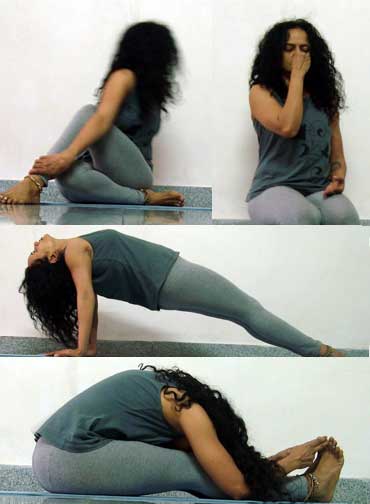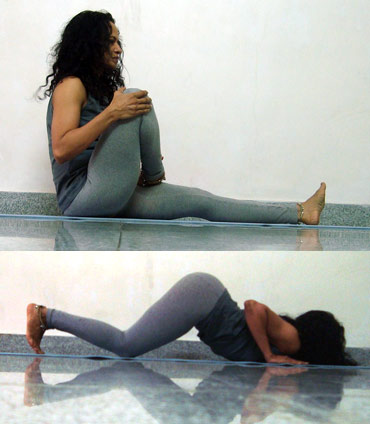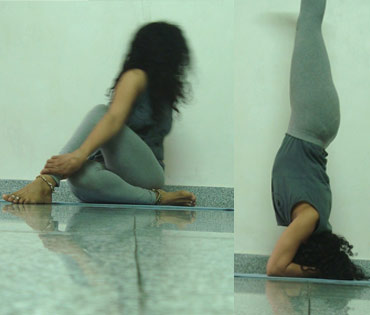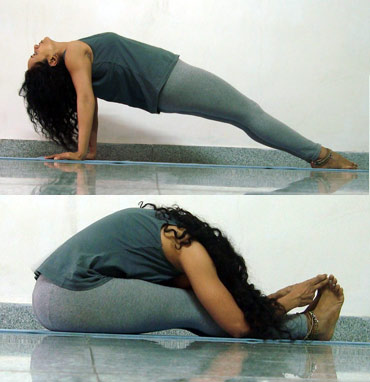Shameem Akthar
Shameem Akthar, yoga acharya trained with the Sivananda Yoga Vedanta Center, takes you through five mistakes you want to watch out against, while on the mat.
A lot of ink is being spent on yoga injuries. Often these occur only because students are not made aware of certain basic precautions to be followed. Injurues can also happen when the instructor does not break up the pose to make it flow in a technically neat manner. A clumsily executed pose often leads to injuries. If you are lucky enough to avoid injury, it could mean the main impact of the pose is diluted so that your time on the mat is wasted.
If you are in a large, noisy class where the attention is diffused, including of the teacher's, it is most likely that your yoga practice is below par. Even if the class is large, poses must be executed in silence and meditatively to be able to encourage the mind-body communication which is the core of any yoga practice.
There are some obvious errors that should be avoided:
- Never do yoga on a full stomach. At least a two-gap after a meal, and around four-hour gap after a longer/ heavier meal.
- Do not keep drinking water through the practice. Yoga is not like any other exercise form. For one, drinking water before an inverted pose could cause intense discomfort, and is regarded as dangerous; it may also lead to acid reflux.
- Never try an advanced variation unless you have mastered the basic pose. For instance, trying the scorpion before you can stay up in the headstand for at least three minutes. Staying up in the basic poses encourages the muscle development and flexibility required for the advanced variation.
On the following slides are five more mistakes you want to watch out against, while on the mat, advises Shameem Akthar, yogacharya trained with the international Sivananda Yoga Vedanta Center.
For more of Shameem's yoga writings visit http://jaisivananda.blogspot.com. Follow Shameem's yoga products on her online shop Yogatique on . Shameem's second book Yoga in the workplace, with photographs by ace photographer Fawzan Husain, is now available at online shops and bookshops across the country.
Disclaimer: This column just shares the columnist's passion for yoga which is ideally learned under the guidance of an expert.
Skipping the warm-up
Image: Sun salute (suryanamaskar) and pawan muktasana series (energy-release poses) make great warm-ups.Ideally for a healthy person, the sun salutes (suryanamaskar) are the best warm-ups. For those with some chronic or serious ailment, the pawan muktasana poses (energy releasing poses) are also ideal.
Unfortunately, some yoga classes take the easy way out and use either of these sequences as the main element of the entire class. These are essentially warm-ups and must be relegated the time you would normally assign to warm-ups: about 10-15 minutes in an hour of practice. The rest should be devoted to asanas or poses.
After a few weeks or months, depending on the nature of growth on the mat, the pranayama practice must also be introduced.
Missing cool-down
Image: Cool-down is very important after practice.The corpse pose or shavasana is the most important practice that is sadly enough given the go-by in many classes. This is the pose usually used for cool-down after practice.
It is necessary to do this if you want the de-stress effect that has made yoga a powerful healing tool. After any practice or even an intense pose, this pose must be done to help ensure the blood lactate levels are back to normal. Lactic acid build-up happens in the body after any hectic muscular effort. The corpse pose helps to clear this away before you move into the next pose or as cool down.
If you move in and out of poses too fast, you will leave your practice feeling fatigued, irritable, stressed or all of them! You have to use this pose to create a healthy gap between your asana (poses) and your pranayama (breathing practices).
An hour of practice would mean a five to ten minutes of shavasana.
Neglecting pranayama (breathing practice)
Image: Pranayama should be part of daily yoga practice.This is an important element of a yoga class or practice. However, since instructions are rather difficult to give most nervous yoga teachers may completely bypass this practice. They will often give various excuses, including from ancient texts, for not introducing pranayama practices in a class.
Also the practices in themselves are simple, even boring. Since some teachers want the classes to be entertaining, and fear a drop in attendance, they compromise by ignoring pranayama. However, in terms of health the value of breathing practices is supreme. So they have to be part of your yoga experience.
The other extreme is where a particular brand of yoga school may ignore the asana practice entirely to devote it to exclusively to breathing practices. This is a rather disturbing practice since asanas prepare your body and lungs for pranayama practice. Doing pranayama exclusively may prove unhealthy in the long run or create emotional disorders.
An hour of yoga practice should include a 15-minute practice at least of pranayama. This period should be devoted to just two breathing practices. Attempting various pranayamas from various classes is another equally disturbing and unhealthy practice.
You have to master one pranayama properly before experimenting even with its advanced version. Also remember each asana is also a breath sequence. Again, because it is difficult to give instructions in this, most teachers will give general instructions. That again neglects the mind-body awareness that yoga seeks to cultivate.
Doing sadhana without sequence
Image: Detox poses like spinal twist must never be done before an inversion.It is essential that your asanas flow in a sequence, whether there are two dozen asanas or so. This is because during the asana, practice the body is releasing toxins. A sequence ensures that toxins flow out of the body and not back into it.
The art of sequencing a class is a delicate one, and most teachers are not very aware of the exact nature of the poses to be able to create a flow. So doing many poses or few is irrelevant if your end result messes up your health! Also very few yoga brands have a sequence in place as the basic structure of their package.
So ensure that you join a class or a type of school where sequence of asanas plays a prime role. For instance, a detox pose (like the spinal twist or ardha matysendrasana/ peacock pose or mayurasana) may never be done before an inversion (headstand or shoulderstand) for the same reason.
Neglecting counter poses
Image: Forward bends need backbends as counter poses.As part of the sequencing of your asana practice, being aware of counter poses is very important. For instance, the counter pose for the shoulderstand is the fish. This is because in the shoulderstand, the neck is flexed so it presses into the thyroid gland. In the counter pose, the opposite movement of the neck, where the neck is bent back, is encouraged. This releases the tension in the neck.
If you are not aware of this or move into another pose (without doing the counter pose) it is likely that you may feel neck pain later on. Similarly, for the seated forward bend (also called the westward facing pose or paschimottanasana) the counter pose is the plank (setuasana). This releases the tension along the entire spine.
For the standing forward bend (uttanasana) the standing backward bend (crescent) must be executed, to release the tension along the spine, especially the lower back.







Comment
article